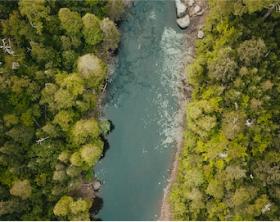Case study
Environmental Monitoring of tidal river Itchen (Southampton, UK)


A 2-month nitrate and nitrite monitoring project on the tidal River Itchen, UK, confirmed expected daily tidal nutrient level changes, dilutive events from rain and revealed a sewage discharge event.
Background
The River Itchen in Hampshire, England covers 26 miles and flows into Southampton Water and the Solent. It is a chalk river designated as a Site of Special Scientific Interest (SSSI) with high-quality habitats for protected species. It was used as a local test site to deploy SWS nitrate/nitrite sensors to demonstrate capability for environmental monitoring in brackish water.
The challenge
This deployment addressed two challenges.
Firstly, to demonstrate key operational capabilities of SWS nitrate/nitrite sensor probes, with the following targets:
- Accuracy & precision: >90%
- Compatibility with total nitrogen levels (nitrate + nitrite), TON: up to 50 mg/L
- Compatibility with brackish water salinity: up to 10 dS/m
On the environmental monitoring side, to pick up key events for river health:
- Effect and regularity of daily tidal events
- Pick-up of any external effects on nutrient levels.
The solution
A SWS DropletSens™ NO3/NO2 sensor probe with 20 µM inlet filter was deployed directly into the river. The device was tethered to a pontoon which moved up and down with the tide.
The sensor was set to autonomously measure nitrate and nitrite levels in the river water every 10 seconds. 30 spot samples were taken over 4 weeks covering all tidal phases, and analysed in the lab to provide accuracy reference measurements. Power was provided via a battery and remote telemetry via mobile broadband, both housed in a small bankside support box.
- Daily tidal TON level changes from up to 40 mg/L during low tide to down to 25 mg/L during high tide, largely due to nitrate
- Strong rainfall events further lowered TON levels to <18 mg/L on selected days
- Suspected sewage discharge from WWTP Portswood, located 400m upstream of deployment site, resulting in temporary nitrite level increases of +2 mg/L
The results
The deployment was successfully completed with key sensor capabilities demonstrated:
- Accuracy vs lab-based measurements: 6.4%
- Precision with internal standard: 5.1%
- TON levels up to 37 mg/L measured with >90% coming from NO3-N
- Accurate measurements through all tidal phases covering fresh to brackish water
The high-density monitoring data (>160,000 measurement points) confirmed expected repeated tidal nutrient level changes and strong outside effects from extreme rainfall events and sewage discharge. Following this pilot success, we continued to partner and use our sensors for environmental monitoring of additional river estuaries and also coastal waters, both domestically & abroad.
This early local deployment demonstrated that our microfluidic sensor technology can be used for remote estuary monitoring. It’s a game changer in terms of data quality and density and will hopefully become a key enabler for widespread discharge monitoring and improved river health
- Dr Oliver Hofmann, CEO, SouthWestSensor Ltd
For full details of this deployment, see Environ. Sci. Technol. 2019, 53, 9677-9685
Questions? We're here to help.